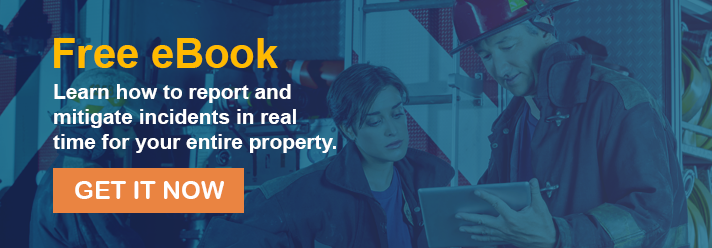2021 is fast approaching.
You need to find out how ‘fast’ your team performed this year.
That way, you can figure out what improvements or changes are needed for the upcoming year.
So, what does your operation look like?
Are you responding to incidents efficiently? Do you have the right amount of resources available? How are your staffing levels? Is it time to invest in a unified solution?
You need to answer these questions, but how?
We’ll save you the guesswork.
You need to use analytics, which means you need the ability to capture data that results in purposeful analytics.
Do you have Proactive Operations in place? Are you in a position to rely on your data? Can you trust it?
You need to close out 2020 and get ready for 2021. Today is a great day to start.
But, the only way to do it successfully is by looking at your numbers.
You must take a close look at how your operation performed this year, so you can be proactive in making the best adjustments for the New Year.
Now is the time to resolve any issues.
Address whether the integrity of your data is at the level it needs to be before you’re already in the first quarter of 2021.
Keep reading; here’s what you’ll need to do.
A FRAMEWORK FOR USEFUL ANALYTICS
Do you use an incident management system? Are you about to put one in place? What is your solution?
Do you have an infrastructure in place? Has it increased your awareness, enhanced communication, or has it led to accurate documentation?
Most importantly, does it provide you with analytics – you can use?
Here’s the bottom line:
- Are you able to collect all the data that you need?
If not, what is affecting this? This must be tackled.
For you to capture analytics that’ll help you look back on this year and prepare for 2021, you need Proactive Operations in place.
- Do you have an infrastructure in place?
- Are you using the best solutions in the marketplace to capture real-time data?
- Is Proactive Operations real at your property?
If you are not sure, we can help.
If your answer is, “No,” please keep reading.
CONTROL DATA FLOW WITH A FIXED INFRASTRUCTURE
Give your staff the ability to communicate, collect, and manage information efficiently. Get useful data.
It is the best foundation for achieving results.
Start with your infrastructure. They are the moving pieces to “nail down.”
Organize it to work cohesively with your solution. Get facts that you need for improving your operation next year.
Ask yourself, who is involved?
Include staff from every associated department of an incident or issue. This is important because it helps you understand where your data lives.
It also lets you know the individual units that are strong and identifies which ones are weak.
ANALYTICS YOU CAN USE
“Why invest in a solution?” and “Why put an infrastructure in place?” and “How do you improve your operation for 2021?” are answered by these two words: using analytics.
Building your infrastructure gives critical analytics. You need analytics to understand the operational effectiveness and readiness.
Analyzing data is how you improve future outcomes.
Create a structure that leads to relevant facts. Use them to learn what you did right and wrong for this year, and how to prepare for next year, through proactive operations.
Generate Real-Time Data from Streamlined Communication
The days of dispatching your team and not receiving status updates are gone.
Next, use it to maximize communication that results in purposeful data.
- Execute instant communication of relevant information.
- Staff in multiple locations are talking to each other with limited or no confusion.
- Organization and clearer initiatives for each department.
Manage, track, and collect the details of an incident or an issue, from start to finish.
Real-time data is the effect of real-time communication. No more missed information.
Purposeful Analytics
You can measure and improve your process for the year to come.
- Response times to wet spills
- Deploying wheelchairs to customers
- Returning lost and found items
- Preventing equipment from breaking
How can you accomplish this?
Begin receiving, collecting, and documenting data that has a purpose. You know, the “stuff” you need!
Our questions below help you make the best operational decisions, which contribute to understanding where you went right this year and what you need to improve for next year.
- How long does it take to receive a call?
- How long does it take to dispatch the incident or issue to appropriate staff?
- How long does it take your responding staff to get on scene to the incident or problem?
- How long does it take your staff to mitigate the conflict and begin responding to the next?
Let us explain their importance for you.
How long does it take to receive a call?
From the time it takes your customers or staff to:
- Identify an incident
- Send a text message via text communication/call it in/report incident via mobile device to your central dispatcher in the command center.
How long does it take to dispatch the incident or issue to appropriate staff?
A slip and fall call comes into the control center. It is determined that there is a food spill at the scene.
The dispatcher must notify medical to look at the customer and housekeeping to clean the area.
How long does it take your responding staff to get on scene to the incident or issue?
From the moment the incident or problem is dispatched to all departments, determine the length of time each unit took to arrive on-scene.
How long does it take your staff to mitigate the incident and begin responding to the next?
These questions help you understand appropriate response times. They will give you the foresight you need to improve your whole operation.
This is how you prove your solution’s long-term worth.
However, do not stop there.
Continue questioning the state of your operation. Use your results. The hard facts you have gathered from your solution leads to more value.
Dive deeper to maximize the value of your solution:
- Will increased staffing result in faster response times or diminish value? What is the cost differential?
- Which locations require a stronger focus on your team’s awareness?
- Do you have hot spots that need a more robust security presence?
- Is training the leading factor in staff performance? Should you conduct more tabletop exercises? Is solution adoption low?
These are only a few of the many questions to ask. As you can see, scrutinizing your operation further one you have reliable data provides limitless insights.
Continuous improvement is a never-ending pursuit. You can only continue the quest if you ‘know’ what you must work within your operation.
STRENGTHEN LIABILITY DEFENSE IN 2021
To your boss, it all ends in dollar signs.
They are here to bring in revenue and to protect that revenue for stakeholders.
Your role is to manage the operation. Your boss’s role is to protect the big picture.
Show your boss how all of this protects the bottom line using the tactics in this article – 2021 is bright.
You now know what to manage and how to improve it. This makes all the difference.
Here’s some perspective.
A fight occurred at your property many years ago. Seven years later, it has come back to haunt you.
The incident occurred at your property under your watch, so you get deposed along with your boss.
You show up with every piece of data related to this longstanding incident.
It took your team two minutes to efficiently respond to a fight, which is a highly regarded response time amongst your peers.
You have the information to show your team does this regularly too. They consistently respond in this timeframe to incidents and issues.
You demonstrate to the court that you are adequately staffed for all events. Kudos, your ability to provide the facts with a digital paper trail is first-class.
Consistent response times are par for the course at your property. You use a highly efficient system.
Plus, could you ask for a better outcome in court than this?
OVER TO YOU
Analytics is going to make a lot more operations Proactive in 2021.
Data is shaping how operations perform already. But, 2021 is going to be the year where analytics helps the industry maximize performance throughout all properties.
We don’t want you just to wait around and see – start using analytics today!
Editor's note: This post was originally published in December 2016 and has been updated for comprehensiveness and freshness.




